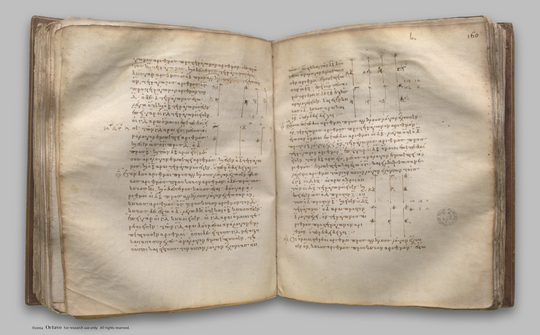index prev next | digilib folio 164

If two numbers have to one another the ratio which a cube number has to a cube number, and the first be cube, the second will also be cube.
| Ἐὰν δύο ἀριθμοὶ πρὸς ἀλλήλους λόγον ἔχωσιν, ὃν κύβος ἀριθμὸς πρὸς κύβον ἀριθμόν, ὁ δὲ πρῶτος κύβος ᾖ, καὶ ὁ δεύτερος κύβος ἔσται. Δύο γὰρ ἀριθμοὶ οἱ Α, Β πρὸς ἀλλήλους λόγον ἐχέτωσαν, ὃν κύβος ἀριθμὸς ὁ Γ πρὸς κύβον ἀριθμὸν τὸν Δ, κύβος δὲ ἔστω ὁ Α: λέγω [ δή ], ὅτι καὶ ὁ Β κύβος ἐστίν. Ἐπεὶ γὰρ οἱ Γ, Δ κύβοι εἰσίν, οἱ Γ, Δ ὅμοιοι στερεοί εἰσιν: τῶν Γ, Δ ἄρα δύο μέσοι ἀνάλογον ἐμπίπτουσιν ἀριθμοί. ὅσοι δὲ εἰς τοὺς Γ, Δ μεταξὺ κατὰ τὸ συνεχὲς ἀνάλογον ἐμπίπτουσιν, τοσοῦτοι καὶ εἰς τοὺς τὸν αὐτὸν λόγον ἔχοντας αὐτοῖς: ὥστε καὶ τῶν Α, Β δύο μέσοι ἀνάλογον ἐμπίπτουσιν ἀριθμοί. ἐμπιπτέτωσαν οἱ Ε, Ζ. ἐπεὶ οὖν τέσσαρες ἀριθμοὶ οἱ Α, Ε, Ζ, Β ἑξῆς ἀνάλογόν εἰσιν, καί ἐστι κύβος ὁ Α, κύβος ἄρα καὶ ὁ Β: ὅπερ ἔδει δεῖξαι. | If two numbers have to one another the ratio which a cube number has to a cube number, and the first be cube, the second will also be cube. For let the two numbers A, B have to one another the ratio which the cube number C has to the cube number D, and let A be cube; I say that B is also cube. For, since C, D are cube, C, D are similar solid numbers. Therefore two mean proportional numbers fall between C, D. [VIII. 19] And, as many numbers as fall between C, D in continued proportion, so many will also fall between those which have the same ratio with them; [VIII. 8] so that two mean proportional numbers fall between A, B also. Let E, F so fall. |